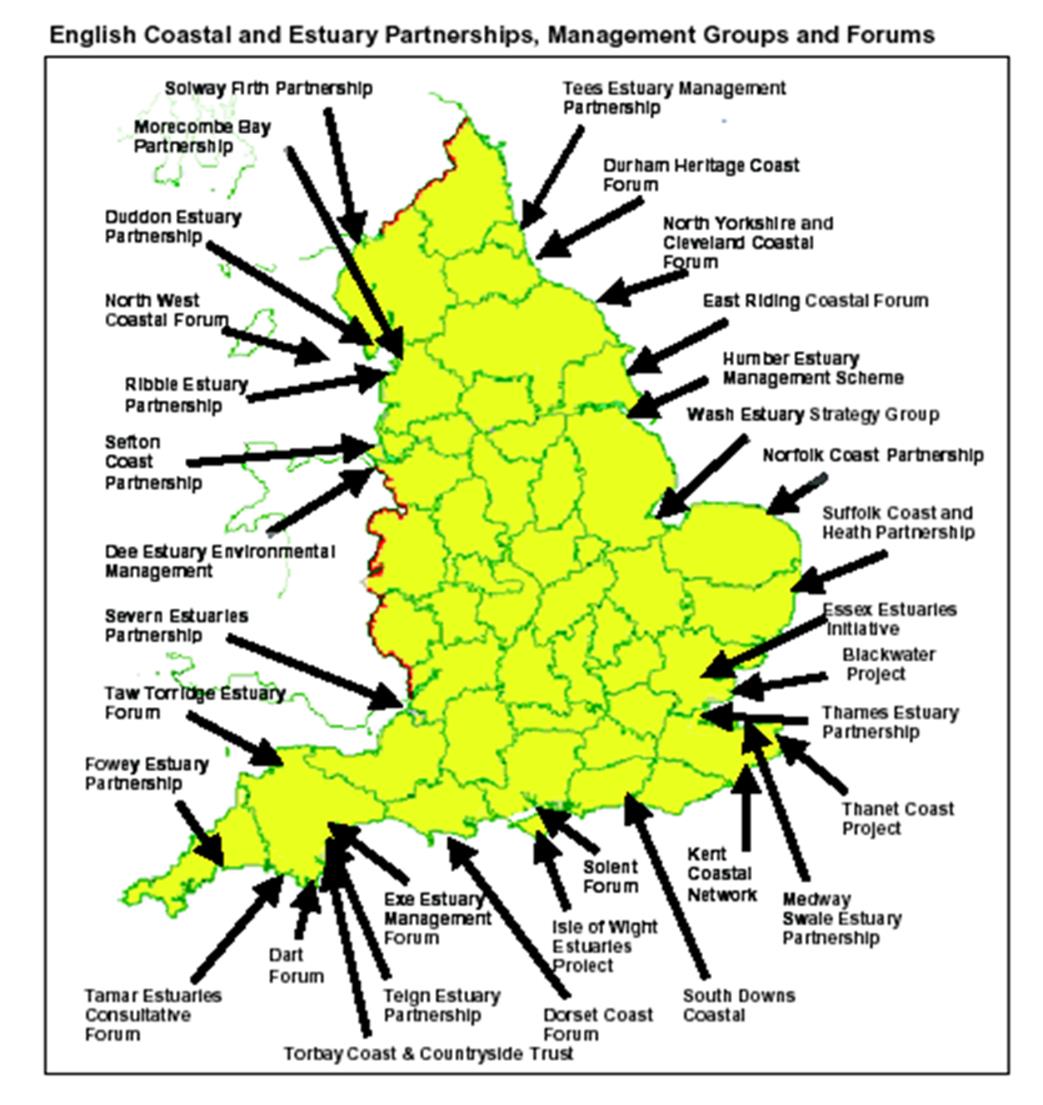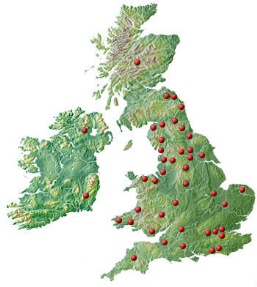For many years, UK coastal practitioners have promoted the need for joined-up planning and management of our coast through ‘Integrated Coastal Zone Management (ICZM)’. This policy framework has received much attention over the past few decades, but was dropped from the EC Maritime Spatial Planning Directive in 2014. However, commitment has been made to ensure consideration be given to Land-Sea Interactions (LSI) during the preparation of new Marine Plans across Europe. This process is now underway around the whole UK coastline.
ICZM has not been given any legal status in Europe, apart from in the Mediterranean through a Protocol being adopted into legislation by some Member States. This contrasts with the US which has a Coastal Zone Management Act (1972), and South Africa’s Integrated Coastal Management Act (2008).

The UK has invested in practical ICZM delivery through a unique set of Coastal Partnerships (see here). Since the 1990s, around forty partnership initiatives have acted as a hub to bring together all those with a role or interest in the management and planning of coastal resources. Initiated through seed-funding from government, some have come and gone, whilst many remain strong and now engage private-sector as well as ongoing public-sector partners and grants from within the UK and EU. For a specific coastal area or estuary, they bring together stakeholders with an interest in the coast – fishermen, harbour masters, boat users, government agencies, industry, academics, local councils, action and community groups etc. Their primary aim is to promote the sustainable use of resources – to encourage information sharing, collaborative projects, resolving conflicts and raising awareness of the value and multiple uses of their coastal area. A wide range of partners tend to provide small financial contributions towards core funding which employs one (or two) people to act as co-ordinators – who then seek additional funds for practical delivery projects.
The longevity of experience and relations established by these partnership initiatives, can benefit decision-making in coastal communities. However, there remains no statutory basis for their role and increasing challenges to financially sustain their co-ordination services. There is little academic scrutiny of their effectiveness or legal context for their co-ordination role.
At this years’ Coastal Partnerships Forum in Durham, I posed the question: ‘how do you see your role in a legal context?‘ With little prospect of legislation to support ICZM, but increasing need to co-ordinate terrestrial planning with new marine planning, is there a new niche for coastal integration?
 First, the question of guardianship was posed. Based on the writings of Christopher Stone in Should Trees Have Standing?, I posed the question of whether there was a gap or overlap in the way we manage the coast, which could be better recognised through law? Whilst ecosystems have not obtained direct legal standing over the past 40 years, there is an increasing amount of legislation and regulation implemented by a complex array of institutions. Environmental quality standards set through EC Directives and UK law (e.g. the EU Water Framework Directive, EU Marine Strategy Framework Directive, EU Habitats and Birds Directives) effectively give the environment legal status but not in its own right. The ecosystem is not always seen as a whole, with monitoring and compliance standards typically based on specific indicators (e.g. water quality, habitats and species occurrence). Coastal Partnership Officers maybe provide a guardian role through their work to champion a coastal area (e.g. estuary, bay) as a whole system serving the interests of the environment, society and economy.
First, the question of guardianship was posed. Based on the writings of Christopher Stone in Should Trees Have Standing?, I posed the question of whether there was a gap or overlap in the way we manage the coast, which could be better recognised through law? Whilst ecosystems have not obtained direct legal standing over the past 40 years, there is an increasing amount of legislation and regulation implemented by a complex array of institutions. Environmental quality standards set through EC Directives and UK law (e.g. the EU Water Framework Directive, EU Marine Strategy Framework Directive, EU Habitats and Birds Directives) effectively give the environment legal status but not in its own right. The ecosystem is not always seen as a whole, with monitoring and compliance standards typically based on specific indicators (e.g. water quality, habitats and species occurrence). Coastal Partnership Officers maybe provide a guardian role through their work to champion a coastal area (e.g. estuary, bay) as a whole system serving the interests of the environment, society and economy.
Secondly, I posed the question of whether Coastal Partnerships are promoting stewardship? This is a more familiar concept to partnership officers, due to funding offered by The Crown Estate for marine stewardship projects. Owning over half of the UK foreshore, they have a duty under the 1961 Crown Estate Act to promote good management. But – like many sponsors and members of Coastal Partnership work – their support is usually limited to specific project outputs. It is challenging to secure ongoing commitment to a co-ordination role with a primary purpose of ensuring good communication, information sharing and community engagement in decision-making. Is there a stronger role for land, foreshore and seabed owners – public, private and the Crown – to support longer-term coastal stewardship?

Finally, the question of trusteeship. Rivers are increasingly being managed through the Catchment Based Approach by Trusts. They appear to be driving integrated management and community engagement on behalf of a river, facilitated by catchment co-ordinators/advisors. A national Rivers Trust network (rather like the Coastal Partnerships Network) provides an umbrella body for over 100 catchment initiatives. Many river catchments have established their own Rivers Trust (see Figure 2). They are normally established as legal entities through charity or company law. Does this give a river more legal standing? It seems to help lever in more funding and government commitment to the co-ordination work. By contrast, only a handful of Coastal Partnerships have established charity or company status. This may be a route towards more financial opportunity and security for the work of Coastal Partnerships.
As a result of the UK’s Marine and Coastal Access Act (2009), several coastal and estuary partnerships have been supporting the Marine Management Organisation’s stakeholder engagement process over the past few years, for the preparation of new Marine Plans. With increasing regulation of the marine environment and new marine plans, consideration of mechanisms for the ongoing engagement of coastal communities in planning and management is required. The work of Coastal Partnerships (such as the Severn Estuary Partnership) may encourage a sense of guardianship or stewardship over coastal resources. There is also an argument to suggest that this is a legal obligation on government and/or landowners, since ‘the absence of appropriate stakeholder consultation structures may deprive regulatory measures of their legitimacy’ (Long, 2012).
The question remains about whether co-ordination mechanisms at the coast require stronger backing and whether there are better governance solutions or legal scope to avoid the ‘gap’ between our management of land and sea.
Natasha Bradshaw is undertaking a PhD in coastal governance at UWE Bristol. A target audience for her research will be UK coastal and estuary partnership officers and their steering group members/directors/trustees, which meet once per year under the banner of the UK Coastal Partnerships Forum. This year, Natasha introduced her research which will invite members of the network to participate in a Delphi process as part of her PhD during 2017.
